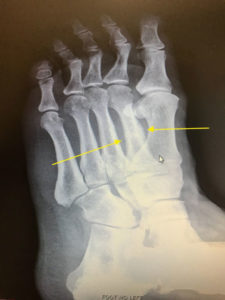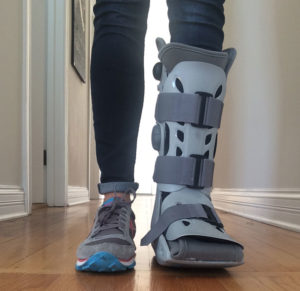19 Mar Stress Fracture
A stress fracture is one type of incomplete fracture in bones. It is caused by unusual or repeated stress.” This is in contrast to other types of fractures, which are usually characterized by a solitary, severe impact. It could be described as a very small sliver or crack in the bone; this is why it is sometimes dubbed “hairline fracture”. It typically occurs in weight-bearing bones, such as the metatarsals(bones of the foot).
It is a common sports injury, and most cases are associated with athletics.


Symptoms
Stress fractures usually have only a few symptoms. A stress fracture could present as a generalized area of pain and tenderness associated with weight bearing. Usually when running, a stress fracture in the leg or foot will cause severe pain at the beginning of the run, moderate pain in the middle of the run, and severe pain at the end and after the run. Additionally, subtle swelling of the affected foot when compared with the other foot can show some

Note subtle swelling or fullness to right foot
Cause
Bones are constantly attempting to remodel and repair themselves, especially during a sport where extraordinary stress is applied to the bone. Over time, if enough stress is placed on the bone that it exhausts the capacity of the bone to remodel, a weakened site—a stress fracture—on the bone may appear. The fracture does not appear suddenly. It occurs from repeated traumas, none of which is sufficient to cause a sudden break, but which, when added together, overwhelm the osteoblasts that remodel the bone.
Stress fractures commonly occur in sedentary people who suddenly undertake a burst of exercise (whose bones are not used to the task). They may also occur in Olympic-class athletes who do extraordinary quantities of high-impact exercise, in professional and amateur distance runners who run high weekly mileage, or in soldiers who march long distances.
Muscle fatigue can also play a role in the occurrence of stress fractures. Consider a human runner. With each stride, large forces are exerted at various places in the legs. Each shock—a rapid acceleration and energy transfer—must be absorbed. Both muscles and bones serve as shock absorber. However, the muscles, usually those in the lower leg, become fatigued after running a long distance and lose their ability to absorb shock. As the bones now experience larger stresses, this increases the risk of fracture.
Previous stress fractures have been identified as a risk factor.
Diagnosis and Treatment
As with most conditions, a stress fracture is diagnosed with a podiatric history and physical exam.
X-rays may not show any evidence of stress fractures, so a CT scan, MRI, or bone scan may be more effective in unclear cases.
If a stress fracture occurs in a weight-bearing bone, healing will be delayed or prevented by continuing to put weight on that limb.
Rest is the only option for complete healing of a stress fracture. The amount of recovery time varies greatly depending upon the location, severity, the strength of the body’s healing response and an individual’s nutritional intake. Complete rest and a cast or walking boot are usually used for a period of four to eight weeks, although periods of rest of twelve to sixteen weeks is not uncommon for more severe stress fractures. After this period activities may be gradually resumed, as long as the activities do not cause pain. While the bone may feel healed and not hurt during daily activity, the process of bone remodeling may take place for many months after the injury feels healed, and incidences of re-fracturing the bone is still at significant risk. Activities such as running or sports that place additional stress on the bone should only gradually be resumed. One general rule is to not increase the volume of training by more than 10 percent from one week to the next.
Rehabilitation usually includes muscle strength training to help dissipate the forces transmitted to the bones.
Bracing or casting the limb with a hard plastic boot or air cast may also prove beneficial by taking some stress off the stress fracture. An air cast has preinflated cells that put light pressure on the bone, which promotes healing by increasing blood flow to the area. This also reduces pain because of the pressure applied to the bone. If the stress fracture of the leg or foot is severe enough, crutches can help by removing stress from the bone.

Typical style boot needed for treatment of stress fractures of the foot and ankle.
With severe stress fractures, podiatric surgery may be needed for proper healing. The procedure may involve pinning the fracture site, and rehabilitation can take up to a half year.

